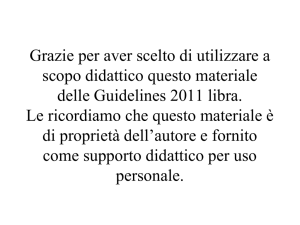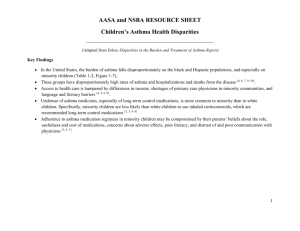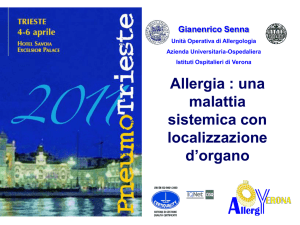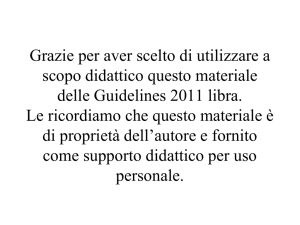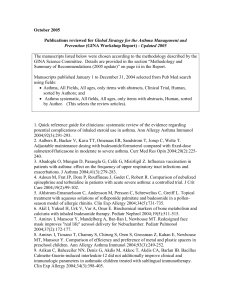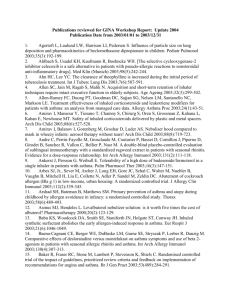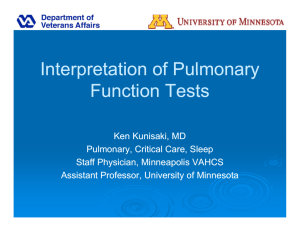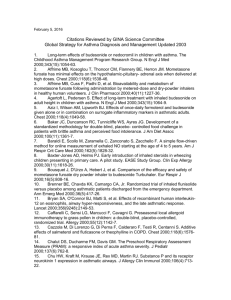Targeting IL-4 and IL-13
advertisement
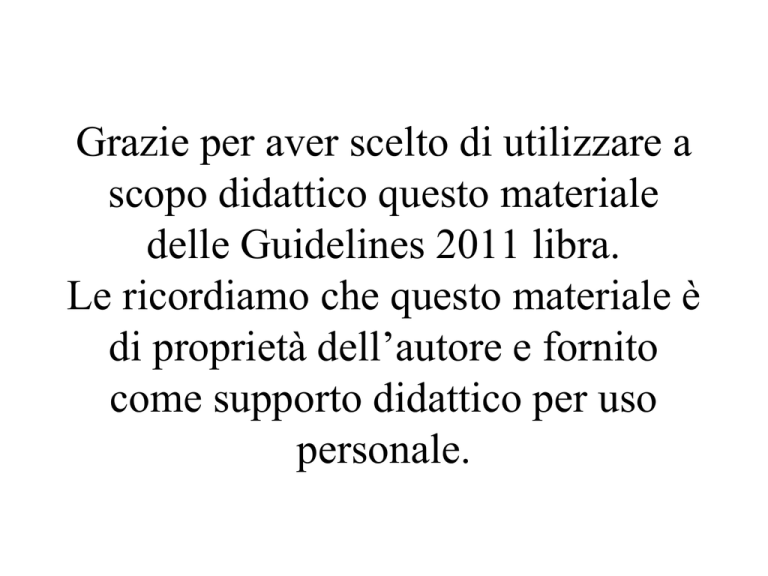
Grazie per aver scelto di utilizzare a scopo didattico questo materiale delle Guidelines 2011 libra. Le ricordiamo che questo materiale è di proprietà dell’autore e fornito come supporto didattico per uso personale. Targeted Therapies in Difficult-to-Control Asthma Paul M O’Byrne EJ Moran Campbell Professor of Medicine Firestone Institute for Respiratory Health, St. Joseph’s Healthcare and McMaster University, Hamilton, Ontario, Canada GINA Guidelines 2011 Phenotyping Empiric Treatment Omalizumab and Difficult-to-Control Asthma Age 39.3 (12-73) Duration of asthma (years) 20.6 (1-61) 39.0 (12-74) 22.7 (2-60) BDP dose (mean [(μg/day) 570 (420-1008) 568 (336-840) Serum total IgE (IU/mL) 172.5 (20-860) 186.3 (21-702) FEV1 % predicted 64.6 (12.5) 64.1 (11.6) FEV1 reversibility (%) 26.9 Puffs of rescue medication 4.9 (2.65) per day during run-in Total asthma symptom 4.31 (1.17) score during run-in 25.9 4.8 (2.51) 4.24 (1.17) Omalizumab and Difficult-to-Control Asthma Busse WW, et al. J Allergy Clin Immunol 2001; 108:184-90 Omalizumab and Difficult-to-Control Asthma Busse WW, et al. J Allergy Clin Immunol 2001; 108:184-90 Bronchial Thermoplasty • Catheter has an expandable wire array at the tip 7 Radiofrequency energy that is converted to heat in the airway wall Monopolar radiofrequency (RF) energy Temperature controlled: 65 °C 10 seconds Signal for successful activation Multiple safety algorithms to ensure controlled energy delivery Bronchial Thermoplasty Miller J D et al. Chest 2005;127:1999-2006 Bronchial Thermoplasty Cox PG, et al. Am J Respir crit Care Med 2006; 173:965-9 Bronchial Thermoplasty Age BDP dose (mean [(μg/day) Seasonal Allergies FEV1 % predicted Asthma Severity Moderate Persistent Asthma Severity Severe Persistent BRONCHIAL THERMOPLASTY 39.4 1351+963 62% 72.6+10.4 CONTROLS 41.7 1264+916 65% 76.1+9.6 38% 47% 62% 53% GINA Guidelines 2011 Phenotyping Empiric Treatment Induced Sputum O’Byrne PM, Nair P. Lancet 2006; 368:794-308 120 BTS management group 100 80 Severe Exacerbations 60 (number) Sputum management group 40 20 0 0 2 4 6 8 10 12 Time (months) GREEN R, et al . LANCET 2002; 360: 1715-21 LOMA study Clinical Strategy Sputum Strategy Number/exacerbations/year (median) 1.5 p=0.01 1.0 1.0 p=0.03 0.77 0.50 0.5 0.46 0 Very Mild Mild Moderate Severe All subjects Pizzichini MMM et al. ERS meeting 2003 Jayaram L, et al. Eur Respir J 2006; 27:483-94 Effect of SCH55700, a Humanized Anti-Human Interleukin-5 Antibody, in Severe Persistent Asthma 26 severe asthmatics. FEV1 49-61% predicted. All on high dose ICS or oral corticosteroids. Blood Eosinophils FEV1 Kips J, et al. Am J Respir Crit Care Med 2003; 167:1655-9 Mepolizumab in asthma • Subjects: – moderate/severe asthma – inhaled corticosteroids up to 1000 mcg/day – symptoms mean 5 on 12 point scale – FEV1 68% predicted • Treatment: – SB 240563 250 mg or 750 mg or placebo Flood-Page P, et al. Am J Respir Crit Care Med 2007; 176:1062-71 Mepolizumab in asthma Asthma Exacerbations (% patients) p=0.06 Flood-Page P, et al. Am J Respir Crit Care Med 2007; 176:1062-71 Subject characteristics Mepolizumab n Age, y (gender, M) Years of symptoms FEV1 % predicted Δ FEV1, exacerbation % Δ FEV1, SABA % Prednisone, mg (years ) ICS, mg LABA, n 9 57.9 (4M) Placebo 10 59.3 (7M) 11.8 9.2 65.5 43.7 68.2 45.0 17.1 10 (9.7) 1000 8 27.4 10 (8.0) 1000 9 NAIR P, et al. N Engl J Med 2009; 360:985-93 Sputum and Blood Eosinophils NAIR P, et al. N Engl J Med 2009; 360:985-93 Prednisone Reduction n=9 n=10 mepolizumab placebo 100 80 prednisone reduction as % of maximum possible reduction 60 40 20 0 p<0.05 NAIR P, et al. N Engl J Med 2009; 360:985-93 Asthma Exacerbations NAIR P, et al. N Engl J Med 2009; 360:985-93. Mepolizumab and Difficult-to-Control Asthma MEPOLIZUMAB 48 PLACEBO 50 BDP dose (mean [(μg/day) 2038 1711 Oral Prednisone 57% 53% 67.9% 68.8% 78.1+20.9 77.6+24.1 6.84% 5.46% 1.98+1.07 2.38+1.35 Age Seasonal Allergies Post-BD FEV1 % predicted Sputum eosinophils ACQ score Mepolizumab in Difficult-to-Control Asthma Haldar P et al. N Engl J Med 2009; 360:973-984 New Drugs for Asthma • Modifications of existing drugs: – – – – Untra-longacting inhaled β2-agonists Modified inhaled corticosteroids Glucocorticosteroid receptor agonists New ICS/LABA combinations • New approaches – – – – – – – – Anti-sense against IL-3, IL-3, GM-CSF and CCR Anti-sense IL-4R Anti-IL-9 Anti-IL-13 Anti-C5a Anti-Ox 40L CXCR2 antagonist CRTH2 antagonists Oligonucleotide Therapeutic Approaches 3. ISS/ CpG motif (ssDNA) 4. Decoy (dsDNA) Competition for TF “Blocks” transcription! 5. Aptamer (DNA or RNA) Nucleus Transcription factor TLR9 DNA (GENE) Promoter RNAseH Transcription Immunostimulation “Blocks” receptor function! RNA Translation PROTEIN RNAseH RISC 2. siRNA (dsRNA) mRNA degradation 1. Antisense (ssDNA) Paolo Renzi MD. Rationale: • By down-regulating the expression of the eotaxin receptor (CCR3) and the common beta chain for IL-3, IL-5, and GM-CSF, – an inhaled anti-sense, ASM8 will inhibit the migration and survival of eosinophils, basophils, mast cells. – and thereby inhibit allergen-induced airway responses. % change from pre-allergen levels % change from pre-allergen levels Effect of ASM8 on βc and CCR-3 mRNA in sputum cells Gauvreau GM, et al. Am J Respir Crit Care Med 2008: 177:952-8. Sputum Cell Counts Pre-dose vs Post Allergen SPUTUM TOTAL CELLS COUNT PRE-DOSE (DAY 1) & 7 HRS POST-ALLERGEN (DAY 3) TOTAL CELLS COUNT (X10 6 CELLS) (Mean +/- SEM) ASM8 4.5 4.0 3.5 3.0 2.5 2.0 1.5 1.0 0.5 0.0 PRE POST PRE POST 1.50 EOSINOPHILS CELL COUNT (X10 6 CELLS) (Mean +/- SEM) PLACEBO 5.0 SPUTUM EOSINOPHILS CELL COUNT PRE-DOSE (DAY 1) & 7 HRS POST-ALLERGEN (DAY 3) PLACEBO ASM8 1.25 1.00 0.75 ** 0.50 0.25 0.00 PRE POST PRE POST * * p= 0.0059 (Placebo vs ASM8) Gauvreau GM, et al. Am J Respir Crit Care Med 2008: 177:952-8. Allergen-Induced Sputum Eosinophilia 1.75 1.25 1.00 p=0.005 1.25 1.00 0.75 0.50 0.25 0.00 screen 1 mg BID 2 mg BID 4 mg BID 8 mg OD Dose Level 0.75 1.2 6 ) 0.50 0.25 0.00 pre 7h 24h Time Post Allergen Challenge Sputum Eosinophils (X 10 24 h post allergen Sputum Eosinophils (X 10 8 mg OD 1.50 7 h post allergen Baseline 1 mg BID 2 mg BID 4 mg BID 6 cells) 1.50 Sputum Eosinophils (X 10 6 ) 1.75 1.0 p=0.043 0.8 0.6 0.4 0.2 0.0 screen 1 mg BID 2 mg BID Dose Level 4 mg BID 8 mg OD Allergen-induced Fall in FEV1 -5 Baseline 1 mg BID 2 mg BID 4 mg BID 8 mg OD 0 5 Fall in FEV 1 (%) 10 15 20 25 30 35 40 0 1 2 3 4 Time (h) 5 6 7 Summary • Phenotyping is important to identify the best choice of treatment in difficult-to-control asthma. • Bronchial thermoplasty is the only novel treatment recently approved for severe asthma. • Anti-IL-5 mAbs appear very promising for asthma with a persisting airway eosinophilia • Many other therapeutic approaches are being studied for the management of difficult-to-control asthma.

